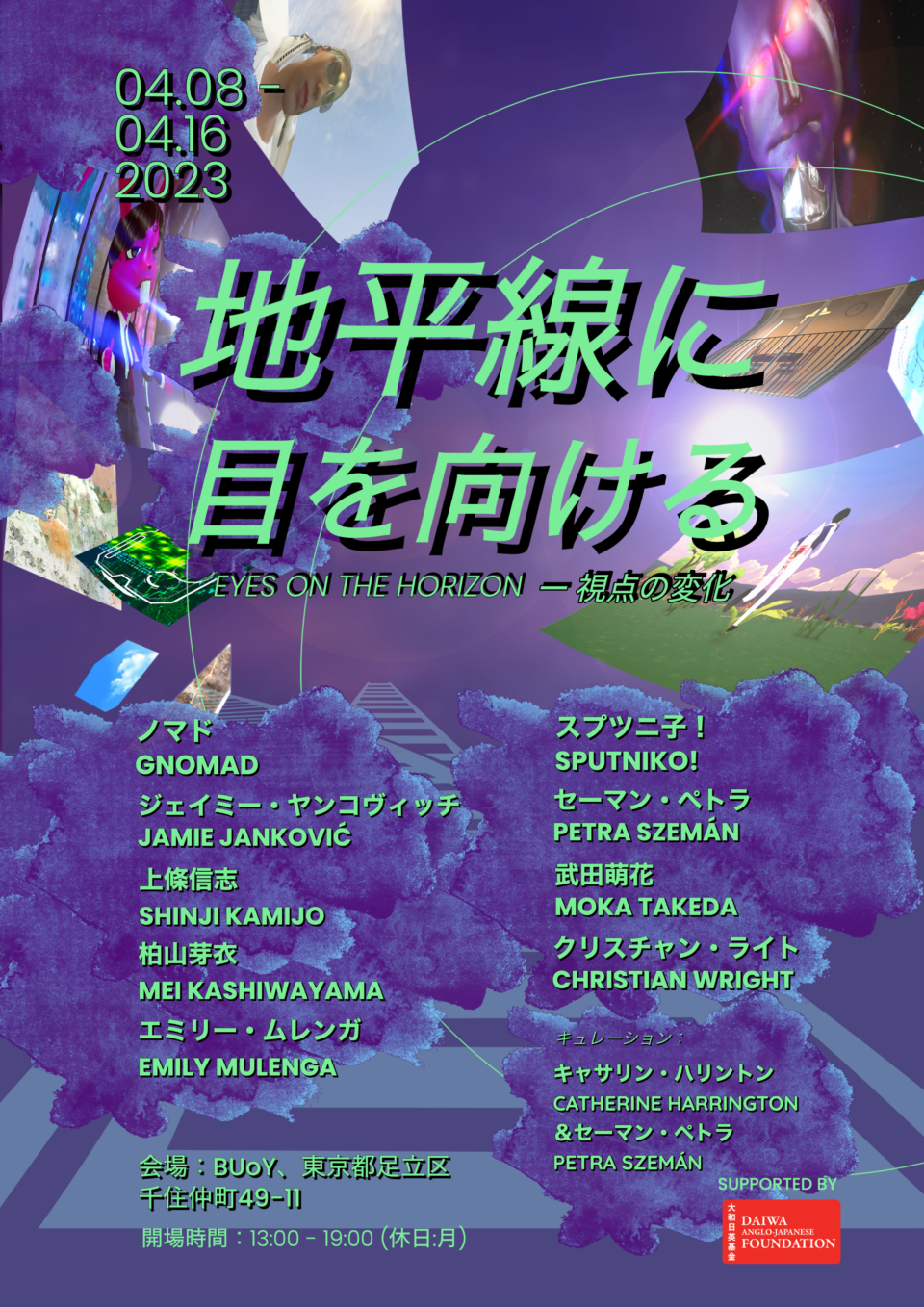
Exhibition
地平線に目を向ける ー視点の変化
キャサリン・ハリントン、セーマン・ペトラ
2023.4.8-16
【ステートメント】
車窓から眺める地平線は決して不変的なものではない。列車に揺られながら視界の中を木々や建物が行き来し、トンネルに入れば窓ガラスの向こうで光が明滅する。地平線とは静止したものに見えるかもしれないが、実は絶え間なく断片化され、見る人とその位置によって解釈され、再構築される。現在の時間と空間を移動しながら地平線は移りゆく。そして新たな可能性を次々と取り込みながら広がり続ける。したがって、地平線に目を向けるということは未来を見据える行為であり、その行為には世界を創造する力が宿る。
トーマス・ラマールは2009年の著書『アニメ・マシーン』の中で、列車に乗ることによってアニメーションの鑑賞体験——列車が動く速度と人間の知覚能力の限界の狭間に生じるアニメーションのようなもの——がいかに再現されるかを考察している(*1)。ノーマン・マクラレンによると、アニメーションの核となる動力は、コマごとに描かれる内容ではなく、コマからコマへと移り替わる際の狭間で起こっているという。このように、列車を乗ることによって生み出されるアニメーションは、私たちに新たな断片化された視点をもたらすのである。アニメーション研究者のデボラ・レヴィットは、このような分裂した不協和な鑑賞体験に関心を持つよう呼びかけ、それを隠すのではなく、むしろ拡張させるよう促している。なぜなら「ミクロの世界やアイデンティティーの狭間にあるつなぎ目や隙間こそが、私たちが仮想性を理解し、関心をよせ、新しい世界を創造することを可能にする」からである(*2)。
『地平線に目を向ける』では、ファンが集う世界、クィアな共同空間、あるいは仮想空間など、異なる断片的な世界を探し求めるアーティストたちの作品を集めた。それぞれの探求において、アーティストたちは決して一つの点に落ち着くことなく、常に先を見据えている。
スプツニ子!の作品《Menstrualverse》では、仮想空間に入り込み、アバターによってジェンダーがどのように演じられるのか、誰が仮想世界をデザインするのか、そこに存在する身体は何ができるのか/どういう能力を持つのかを問いかける。デジタル空間において装着可能な「生理マシーン」が提供されるこの作品では、デジタルアバターが生理になることが何を意味するのか、あるいは逆に、メタバースやその他の仮想領域が、生理やその他の生物学的およびアイデンティティに基づく習慣的行為が検閲される場所になるということが何を意味するのか、という問いを提示する。
エミリー・ムレンガとクリスチャン・ライトの映像作品は、現代アート、アニメーション、アニメファンの世界、アバターといった重なり合う世界の間を行き来する。ムレンガの作品《Main Character》では、3D映像、2Dアニメーション、実写映像の間を行き来しながら、恋愛の終わりをきっかけに存在と現実の本質について考えるようになる「Bunny」を追う。テレビゲーム『Dark Souls III』(2016)内で撮影されたライトの大作《Body Language》もまた関係性に焦点を当てたもので、二人のオンラインプレイヤーが、粗悪なゲームデザインとゲームプレイといった制限の中でどのようにコミュニケーションを図るかを描く。
武田萌花の作品は、「風景」という概念そのものを問い直し、私たちが見る風景は本当に「見られる」ことができるものなのか、それとも私たちは風景を、関連する記憶や思い出を呼び起こしながら眺めていだけに過ぎないのか、といったことを問いかける。
一方、上條信志の作品は、向かいのビルの部屋を見つめる自分の視線を再現し、その「裏窓」から見える人々の人生の物語を想像することで、「他者」のランドスケープと人生について語ろうとする試みである。
ホセ・エステバン=ムニョスにとってクィア性とは、現在に存在するユートピア的な絆やつながり、デザイン、ジェスチャーに垣間見える「存在の地平線(horizon of being)」(*3)として作用し、ある種の「前途洋々たる未来(forward-dawning futurity)」(*4)とともに存在するものである。自然の風景の中にクィアやノンバイナリーの人物を描く柏山芽衣の作品の中では、穏やかな抵抗と粘り強さからこうした絆や未来への視線を感じ取ることができる。
ジェイミー・ヤンコヴィッチとセマーン・ペトラの両作品では、ゲーム空間やアニメーションの領域に入り込む。ヤンコヴィッチの作品『A Woman on the Internet (or, The Eternal Scream)』は、ゲーム内のクィア/トランスのプレイヤーや移動する者がどのように解放を見出せるかを探求する旅である。
一方、セマーンのインタラクティブ・ゲーム『来たるセカイの形』では、ジェンダークィア/トランス*の欲望が、まだ定義されていない未来の在り方と空間をどのように提示できるかを探る。クィア・アイデンティティーに内在する抵抗に着想を得ているノマドによるパフォーマンスとインスタレーションは、クィアな体験の中に解放の場を見出す。
翻訳: 森本優芽
引用文献:
(*1)トーマス・ラマール『ザ・アニメ・マシーン』、13ページ(日本語訳は藤木秀朗監訳,大崎晴美訳『アニメ・マシーン : グローバル・メディアとしての日本アニメーション』を参照)
(*2)デボラ・レヴィット『ザ・アニマティック・アパラティス』、123ページ
(*3)フッサールを引用
(*4)ホセ・エステバン=ムニョス『クルージング・ユートピア』、23ページ
会期:2023年4月8日(土) – 4月16日(日)
会場:BUoY, 〒120-0036 東京都足立区千住仲町49-11
開場時間:13:00 – 19:00
閉場日:月
入場料:¥500
助成:大和基金
協力:東京藝術大学毛利嘉孝研究室
キュレーション:キャサリン・ハリントン、セーマン・ペトラ
アーティスト:ノマド、ジェイミー・ヤンコヴィッチ、上條信志、柏山芽衣、エミリー・ムレンガ、スプツニ子!、セーマン・ペトラ、武田萌花、クリスチャン・ライト
【Exhibition Info】
Schedule: 8th (Sat) – 16th (Sun) April, 2023
Venue: BUoY
49-11, Senju-Nakacho, Adachi-ku, Tokyo
Hours: 13:00-19:00
Closed: Mondays
Admission Fee: ¥500
In cooperation with: Mouri Lab, GA Department, Tokyo University of the Arts
Supported by: The Daiwa Foundation
Artists: gnomad, Jamie Janković, Shinji Kamijo, Mei Kashiwayama, Emily Mulenga, Sputniko!, Petra Szemán, Moka Takeda, Christian Wright
Curators: Catherine Harrington, Petra Szemán
————————————————————————————————————————
【Statement】
A view of the horizon through a train window is never a static image. As you move with the train, trees and buildings slide in and out of the frame; and sometimes the train dives into a tunnel flashing and flickering with light beyond the window glass. The horizon may seem like a fixed point, yet it is perpetually fragmented, interpreted and re-interpreted by the viewer and their position. By moving through present time and space, the horizon shifts; continually expanding to include new realms of possibility. Glancing towards the horizon then, is a future-facing action that in turn possesses worldmaking powers.
In his 2009 book “The Anime Machine”, Thomas Lamarre considers how trains can reproduce the animation-viewing experience; that is, the sort of animated image that is produced in the gaps between the speeds enabled by railway travel and the limited ability of the human perceptual system. (Endnote 1) Paraphrasing Norman McLaren, the core kinetics of animation take place not in the content of the frames, but rather in the spaces as one frame flips to the next. In this way, animation-by-train creates a different, fragmented way of seeing. Animation scholar Deborah Levitt calls particular attention to such fractured and discordant viewing experiences, and rather than concealing them she urges us to enhance them, as it is in “the hinges or gaps between microworlds and identities that allow us to see and attend to virtuality as well as to create new worlds”. (Endnote 2)
“Eyes On The Horizon” brings together the works of artists who seek out different, fragmented worlds, whether it is the interpersonal worlds of fandom, spaces of queer communality, or virtual realms. In this quest, the artists persist in looking forwards, never quite settling. This final exhibition in the series features the artists: Jamie Janković, Shinji Kamijo, Mei Kashiwayama, Emily Mulenga, Sputniko!, Petra Szemán, Moka Takeda, and Christian Wright.
Sputniko!’s work “Menstrualverse”, enters into virtual spaces to ask how gender is performed by avatars, and who should design virtual worlds and what the bodies within them are capable of. Offering a Menstruation Machine as a wearable in digital space, the work presents questions about what it might mean to acquire the ability to perform menstruation as a digital avatar, or conversely, what it might mean for the Metaverse and other virtual domains to be places where menstruation and other biological and identity-based rituals are censored.
Both Emily Mulenga and Christian Wright’s video works tread between the overlapping worlds of contemporary art, animation, fandom and avatars. Mulenga’s film “Main Character” follows ‘Bunny’ as the end of a relationship slingshots her into reflections on the nature of being and of reality, with the film itself flipping between 3D visuals, 2D animation and live action footage. Filmed within the video game Dark Souls III (2016), Wright’s epic “Body Language” also fixes on a relationship; this time between two online players and how they communicate using the shonky limitations of game design and gameplay.
Made in 3D virtual space during the pandemic lockdown in 2020, Moka Takeda’s work “What is a Landscape?” interrogates the idea of landscape itself, and asks if any landscape we see can ever really be “seen”, or if we are only recalling our own memories of a landscape.
Meanwhile, Shinji Kamijo’s work attempts to narrate the landscape of the ‘other’ and others’ time, by re-creating his own gaze into the rooms of a building across the street; imagining the life stories of the people he sees within that ‘rear window’ view.
Mei Kashiwayama’s paintings narrate queer and non-binary figures in a landscape. Queerness for José Esteban Muñoz is a “horizon of being” (Endnote3) that can be glimpsed in utopian bonds, affiliations, designs, and gestures that exist within the present and with a kind of “forward-dawning futurity” (Endnote 4). We can sense these bonds and glance to futurity in the gentle resistance and persistence of Kashiwayama’s work.
Moving towards other, queer horizons in game-space, Jamie Janković’s work “A Woman on the Internet (or, The Eternal Scream)” is a journey into how queer/trans players and travellers in games can find both limitation and freedom; while Petra Szemán’s interactive game “The shape of worlds to come” interrogates ways in which genderqueer/trans* desire might offer as yet-undefined future spaces of being. Composing a world through gesture and story-telling, gnomad’s compelling performance practice builds on similar themes to find liberation in alternate, binary-traversing horizons of being.
Translation: Yume Morimoto
Endnotes:
Thomas Lamarre, The Anime Machine, pxiii
Deborah Levitt, The Animatic Apparatus, p.123
Drawing on Husserl.
José Esteban Muñoz, Cruising Utopia, p23



